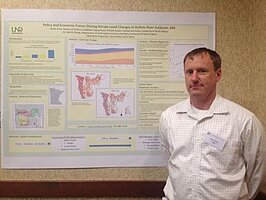The Impact of Policy and Economic Drivers of Corn Production on Nitrogen Levels of the Buffalo River Subbasin, Minnesota, 2006-2014

Brent Silvis is a Master of Science student in the Earth System Science and Policy program at University of North Dakota. Brent has earned a Bachelor of Science in Environmental Science from Slippery Rock University in Pennsylvania and a Bachelor of Science in Business Management from Western Illinois University. Currently, his research focuses on the influence of policy and economics on land use and the corresponding effects on water quality.
Email: brent.silvis@my.und.edu
Phone: 701-885-1548
Fellow: Brent Silvis
Advisor: Dr. Haochi Zheng, Ph.D., Assistant Professor, Department of Earth System Science and Policy, University of North Dakota.
Degree Progress: M.S. in Earth System Science and Policy, with expected graduation in fall of 2015.
The Impact of Policy and Economic Drivers of Corn Production on Nitrogen Levels of the Buffalo River Subbasin, Minnesota, 2006-2014
Various economic forces and policy instruments, such as increased ethanol production and farm subsidies, drive changes in land use. Areas of Minnesota have recently seen changes in land use and management, primarily a transition towards intensive corn production. This study evaluates how economics and policy can influence land use and management has affected water quality.
The Soil Water and Assessment Tool (SWAT) will be used to model the hydrology of the study area. Direct costs, potential crop yields, policies and crop prices are integrated into an economic model which identifies the optimal land use for farmers. The effect of various changes in these factors on production can be projected. Examples of scenarios include changes in crop demand and price, mandated conservation practices or changes in farm subsidies. These scenarios can then be introduced into the SWAT model to determine their influence on water quality.
Project Objectives:
- Well-calibrated SWAT model simulating streamflow and nutrient loads.
- Economic model providing optimal land use for agricultural production.
- Provide guidance to decision makers regarding the influence of policy, economics and land use on water quality.
Progress:
Primary components of the economic model have been compiled. Extensive research into agricultural practices within the study area and trends in land use has been conducted. Inputs for the SWAT model have been collected. Calibration of the SWAT model is ongoing.
Significance:
Agricultural land use can have a profound effect on water quality. Various practices can result in nitrogen, phosphorus and sediment export to surface waters. This can lead to ecological damage and large costs to industry and government. By identifying policy instruments that can prevent water quality degradation and maximize returns to land owners, these costs and damages can be avoided without disrupting energy or food supply or compromising economic returns.
Conference/Seminar Presentations:
Brent Silvis. “The Impact of Policy and Economic Drivers of Corn Production on Nitrogen Levels of the Buffalo River Subbasin, Minnesota, 2006-2014.” Geological Society of America North-Central Section Meeting, May 2015. Madison, WI. (Oral Presentation)
Brent Silvis. “Policy and Economic Forces Driving Nitrate Level Changes in Buffalo River Subbasin, MN.” North Dakota Experimental Program to Stimulate Competitive Research State Conference, April 2015. Fargo, ND. (Poster Presentation)
Brent Silvis “Policy and Economic Forces Driving Nitrate Level Changes in Buffalo River Subbasin, MN.” University of North Dakota Scholarly Forum, March 2015. Grand Forks, ND. (Poster Presentation)

Haochi Zheng
Earth System Science & Policy
Office: Clifford Hall, Room 300
4149 Campus Road - Stop 9011
Grand Forks, ND 58202-9011
Telephone: 701-777-7656
Email: hzheng@aero.UND.edu


